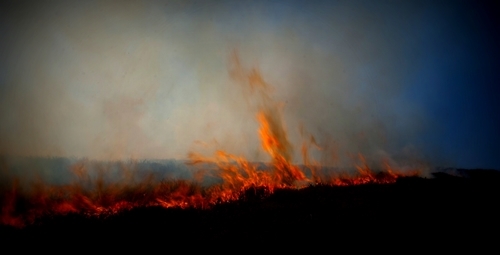Written by Alastair Leake, Director of Policy & Allerton Project
3 Minute Read

Photo: Snipps Whispers (CC BY-NC-ND)
The one thing Covid 19 has taught us well, is that prevention is better than cure, if indeed one is lucky enough to survive to be so. Preventative vaccination is the now main solution to protecting the global human population, coupled with some isolation. In unvaccinated, high density human populations the virus spreads like wildfire. The same can be said of high density vegetation of heather and grass in the uplands. The preventative burning of limited patches during the winter months supresses the build-up of surface fuel and isolates it into pockets which, in turn, prevents wildfire ripping through it uncontrollably, something experts say we can expect more of; just like global pandemics.
Yet last month, in the House of Lords, a motion was brought forward to ban the practice of controlled vegetation burning, supported by some of the organisations most responsible for the conservation of our uplands. These people refer to this practice incorrectly as “peatland burning”.
We know that this description is incorrect because when the controlled fires are lit we make sure the peat is damp enough not to burn. In fact there is published evidence that the searing of peatland surface and charred vegetation left behind contributes towards the stable stocks of carbon in these peaty soils, rather than diminishing them. But that science doesn’t support their story, so we don’t hear about it.
When peatland really does burn, is when unmanaged surface vegetation burns out of control. Such an incident took place on Saddleworth Moor in the summer of 2018, covering a huge 7 square miles. Ignoring the devastation this caused to wildlife, which is shocking enough when it occurs, as it did, in the breeding season for ground nesting birds, it is estimated over 200 years of stored carbon was incinerated.
Now that really is peatland burning.
A similar tragedy at Marsden Moor, in 2019, on peatland which is “cared for” as a National Treasure. In fact, so cared for by people, that the public voluntarily gave £100,000 of their own money to restore the damage, only to find their money burnt by wildfire again last month. Money up in smoke – literally. No cure to be had here then.
Experts say that much of the blame is down to drainage systems, historically installed to improve grazing for livestock, which means the peat dries out. I’m sure there is truth in this and blocking drains and re-wetting must be a key part of the insurance package needed to prevent our Nationally Treasured peatland turning into another uncontrolled firestorm.
Ignoring the peat, surface vegetation will still burn out of control at the wrong time of year for wildlife where it is not managed. And re-wetting diminishes the quality of grazing. So off go the sheep. Surely, with no woolly lawnmowers, there is even more dry grass to flare up?
But let’s leave the sheep and the peat in the uplands, and go down to the noble Lords, where speaker after speaker repeated the contents of an inaccurate and misleading brief that had been circulated ahead of the debate. Mercifully, those honourable members with a historical, and often first-hand knowledge of vegetation management, were able to contain the blaze of misinformation. And merciful it is too, because the motion was narrowly defeated, leaving those who brought the idea of a ban forward the opportunity to go off, before they burnt their bridges, to change their minds, and hopefully take some effective preventative action. Just like they did when they queued up for their Covid jabs.